Guide to Pipe and Cable Locating

Don’t let a buried pipe or cable keep you from performing your job. If you need to bury your own cable or dig a foundation, discover how a
pipe locator can improve the safety of your project. Explore the different types of locators, the benefits of using one and all the answers to commonly asked questions. Keep your jobsite safe and free from accidental utility damage with the latest location devices from Engineer Supply.
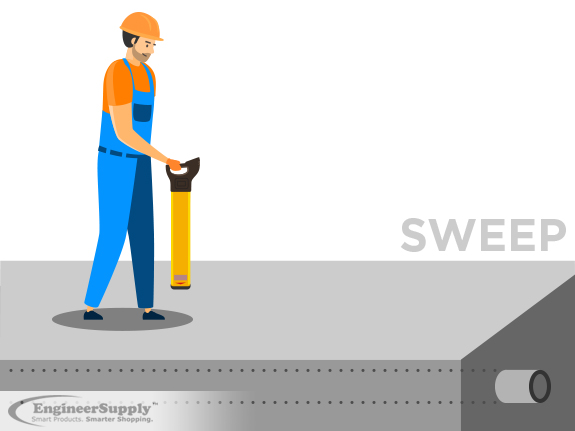
How Underground Cable Locators Work
There are many different types of
utility locator devices, but they all use the same basic techniques. By injecting an electrical signal, either directly or indirectly, they provide a strong signal that a handheld locator can find from the surface.
Before comparing locating techniques and signal types, it’s important to distinguish two basic components. Locators usually use a receiver and a transmitter to establish a connection. The receiver is a handheld device that you can easily sweep above the ground. The transmitter either connects to the electrical supply, connects to the pipe or is fed through the pipe. A low-frequency radio current is sent to establish a connection and allow you to identify the precise location of the cable or pipe.
The signal strength depends on the technique used and the strength of your transmitter. Compare different KHzs of various locators to discover the best tool for your particular project. Review locating techniques to find the best transmitter and receiver combination to get the job done quickly and safely.
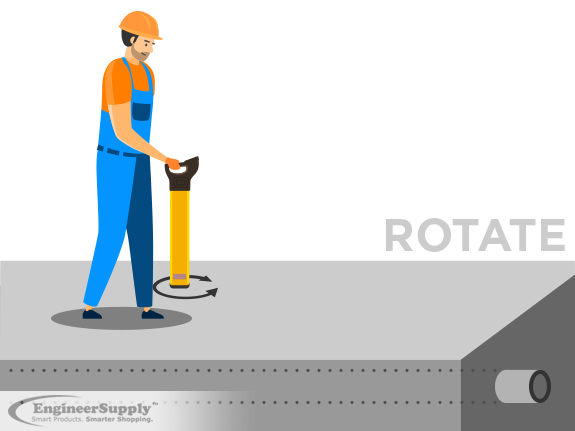
Locating Techniques
Determine the best locating technique based on the type of utility you’re searching for. A passive sweep of the ground around your work project is a great way to find an unknown object. Simply turn on the passive sweep or power mode and make a series of swipes across the area you’re working. Create a survey grid to avoid covering any area. A passive sweep isn’t the most efficient location method but does allow you to find any utilities that are unknown or abandoned.
A direct connection locating technique occurs when you can plug a connection cable into your transmitter’s output socket. This allows a direct connection to the target line, which applies a signal to a metallic pipe or conduit.
Finally, an induction sweep is another locating technique that can be used to find a pipe or cable that you don’t have access to. Similar to a passive sweep, an induction sweep doesn’t require a transmitter to be connected to a line. Turn on this feature and easily find any buried utilities that are six feet or less underground.
Benefits of Finding Buried Utilities
Use an
underground utility locator to avoid the stress and cost of damaging existing utilities. Whether burying a new line or excavating a site for a foundation, it’s essential to understand all the buried utilities in your work area. Gas lines, water lines and electrical cables all present working hazards if you begin digging or trenching without first marking them.

Frequently Asked Questions
What Is a Locator?
Pipe and utility location devices use very low frequency radio waves to identify the location of buried pipes and cables. Powerful locators can find the exact break in a line, while smaller locators are designed to only give you the basic location of a large pipe or metal conduit.
What Types Signals Help Find Buried Utilities?
Use a
pipe locator to transmit a passive or active signal. Passive signals naturally occur in the utility you’re searching for, such as the current flowing through a buried electric supply line. Active signals are sent directly through with the express purpose of locating the buried utility.
What Utilities Are Commonly Buried?
All types of utilities are buried in the ground for your safety and convenience. Electric mains, gas, water and sewer lines are all the most common buried utilities, but you can also find telecommunication lines and cable TV lines in the ground. Any of these lines can be easily disturbed during an excavation if you don’t know their location.
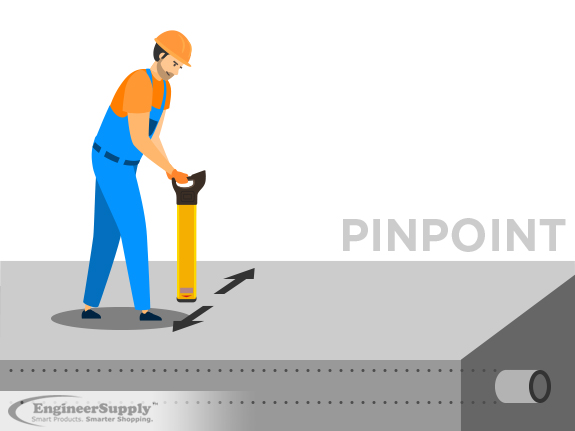
How Can I Compare Locator Devices?
Compare the latest brands and models of pipe location devices to find the best option for your professional project. The best location tool depends on the types of utilities you’re searching for, the transmission strategy you’re using and your budget. Use these and the signal strength of the transmitter to determine the best locator.
What Is the Best Pipe Locator?
The best pipe and
cable locator device depends on your needs. Are you looking for a small break in a line or performing a passive sweep for any missing lines and pipes in your area? Determine your primary method of searching before finding the best locator for your application.
Shop for locators today at Engineer Supply to enjoy affordable options for any pipe locating project. Avoid damaging existing utilities and keep your jobsite free from gas leaks and other hazards with these helpful detection devices.
Best Pipe Locators
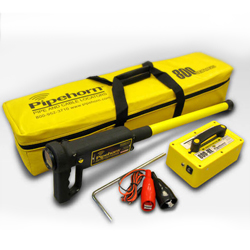
This dual-frequency underground utility locator is always recommended over Pipehorn’s single-frequency model. Because it has the 9kHz frequency that’s needed to find utility lines buried deeper underground, it has the range you need to find a number of underground pipes and cables. With its superior high-frequency performance, it's one of the best utility location tools in the industry when direct connect isn’t possible. And for the toughest conductors (such as coated iron pipes with insulated joints or street and parking lot lights), nothing else will sweep an area for unmarked utility lines than this utility locator.
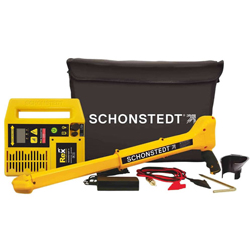
This multi-frequency pipe locator by Schonstedt is a great choice for the working professional, because it has the following features:
- The transmitter is less than 2 inches thick and weighs less than 4 pounds.
- The entire unit fits easily into a custom storage bag.
- The receiver and transmitter together weigh under 7 pounds for an ultralight design.
- The receiver can retract for easier carrying.
- Capable of 512 Hz, 33 kHz, and 82 kHz frequency detection.
- Capable of 50/60 Hz passive and 512 Hz sonde detection.
- The transmitter comes with rechargeable batteries.
This unit is built for utility professionals in the water, sewer, gas, electric, and telecommunication industries.
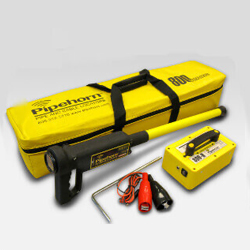
With the ability to detect frequencies of up to 480 kHz, this pipe locator can find utility lines that are buried down to 18 feet deep (depending on the type of connection, the condition of the soil, and how well it can conduct the signal). It also has a fast-response signal strength and a sharp audio tone that allows for precision pinpointing. And with a watertight reinforced receiver wand, it's incredibly durable. The transmitter has a high-impact ABS housing that’s bright yellow, so it’s easier to see.
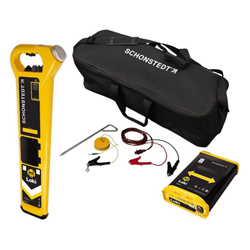
This utility locator is perfect for “sweeping” a large area to find buried assets quickly and easily. The Schonstedt Loki has a number of features that support the quick and easy detection of underground utility lines. Some of them include but may not be limited to:
- The 512 Hz frequency can be used to trace metallic pipes, while the 82 kHz frequency can find hard-to-locate jointed pipes.
- The simple mode selection matches the device to the signal type you need to locate.
- The Sonde Mode can find a signal being transmitted by a compatible sonde.
- The Transmitter Mode can find transmitter signals being imposed on buried utilities.
- The Power Mode can find the electromagnetic fields being generated by loaded power cables.
- The Dual Mode simultaneously searches for and identifies transmitter and power signals for quicker sweeps.
- The ShallowAlert feature will warn you of the possible presence of shallow cables and utility lines in every mode.
- The NoiseProtect feature allows you to use the device in areas that are electrically noisy.
Be sure to pick yours up at Engineer Supply today!
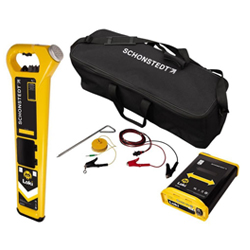
With a receiver that weighs 4.9 pounds and a transmitter that weighs 4.0 pounds, this unit is a lightweight tool that’s perfect for finding pipes, cables, and underground utility lines in large areas. It also has a IP54 rating, which makes it resistant to water and dust. The transmitter has a built-in speaker that generates an audio signal, which can be heard over road traffic. The receiver also has a detachable speaker that can double as an earpiece.
If you’re looking for an underground utility locator to help you find buried pipes and cables, be sure to look at what we have at Engineer Supply.
Please Wait...
